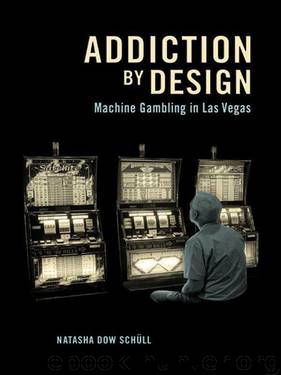Addiction by Design: Machine Gambling in Las Vegas by Schüll Natasha Dow

Author:Schüll, Natasha Dow [Schüll, Natasha Dow]
Language: eng
Format: epub
Publisher: Princeton University Press
Published: 2012-08-19T22:00:00+00:00
Earlier, Terry called Las Vegas the âboot camp of problem gambling recovery.â As her words attest, the cityâs extensive machine gambling infrastructure is overlaid with a robust therapeutic network for those who become compulsively caught in its devices.1
Tacked to the wall above a bank of video poker machines in a gas station serving a residential neighborhood that I visited in 1998, flyers advertised self-help groups, fee-based clinics, and other locally available therapies to treat gambling problems (see fig. i.3, bottom). The machines themselves bore stickers indicating the 1-800 number for Gamblers Anonymous (GA), a fellowship that held approximately one hundred meetings per week in Las Vegas and its suburbs.2 In 1997, a for-profit group called Trimeridian Resources for Problem Gambling opened a Las Vegas clinic offering a range of individual and group counseling options.3 As locals learned through regular radio advertisements, the Eli Lily pharmaceutical company had commissioned Trimeridian to recruit local video poker players for a double-blind experimental trial involving the drug Zyprexa, a widely prescribed antipsychotic that researchers hoped might also reduce cravings to gamble.4 The trial was based at Charter Hospital, which housed an in-patient treatment clinic for problem gamblers from 1986 until the national collapse of its hospital chain in 1998. After Charter closed, the clinicâs former director, Robert Hunter, founded the nonprofit Problem Gambling Center in a blighted downtown neighborhood. The center, which charges only $5 to attend a group counseling session, was established with financial support from Station Casinos, among other local gambling businesses.5
At first glance, therapeutic enterprises would appear to operate at cross-purposes with commercial gambling. While the gambling industry designs techniques and technologies to induce extended consumption, the recovery industryâcomprising researchers, funding bodies, in-patient and outpatient therapy groups, and purveyors of individual counselingâdesigns techniques and technologies that promise to weaken the bind of this consumption. Given the pursuit of objectives that are so precisely at odds, one might expect the methods of the two industries to differ alsoâyet they share two crucial traits. First, both are geared around the idea that behavior can be modified through external modulation; like gambling machines, therapeutic products are designed to be âuser-centricâ and amenable to custom tailoring. Second, both work by bringing about in their users a state of affective balance that insulates them from internal and external perturbations.
The resonance between machine gamblersâ employment of gambling technologies and their employment of therapeutic technologies evinces the blurring of the line that might otherwise cleanly separate recovery from addiction; in both, gamblers seek means of self-modulation that can produce a continuous, homeostatic state and keep risk at bay. As we will see, the attentive state of balance they characterize as ârecoveryâ bears an uncanny resemblance to the tensionless state they call âthe zone.â âThe kind of serenity I feel when Iâm doing my [therapy] exercises comes closest to the serenity I felt at the machines,â Terry told me. It is not only that gambling addictsâ machine play is isomorphic with their therapeutic practices, but also that a certain
Download
This site does not store any files on its server. We only index and link to content provided by other sites. Please contact the content providers to delete copyright contents if any and email us, we'll remove relevant links or contents immediately.
The Art of Thinking Clearly by Rolf Dobelli(8839)
Mindhunter: Inside the FBI's Elite Serial Crime Unit by John E. Douglas & Mark Olshaker(7833)
Change Your Questions, Change Your Life by Marilee Adams(6639)
Nudge - Improving Decisions about Health, Wealth, and Happiness by Thaler Sunstein(6633)
Mastermind: How to Think Like Sherlock Holmes by Maria Konnikova(6233)
The Power of Now: A Guide to Spiritual Enlightenment by Eckhart Tolle(4751)
Men In Love by Nancy Friday(4319)
Factfulness: Ten Reasons We're Wrong About the World – and Why Things Are Better Than You Think by Hans Rosling(4020)
The Confidence Code by Katty Kay(3566)
Thinking in Bets by Annie Duke(3530)
Man and His Symbols by Carl Gustav Jung(3314)
Three Women by Lisa Taddeo(2918)
The Worm at the Core by Sheldon Solomon(2916)
Why Buddhism is True by Robert Wright(2825)
Liar's Poker by Michael Lewis(2809)
The Inner Life of Animals by Peter Wohlleben(2765)
Descartes' Error by Antonio Damasio(2731)
The Power of Mindful Learning by Ellen J. Langer(2709)
The Slow Fix: Solve Problems, Work Smarter, and Live Better In a World Addicted to Speed by Carl Honore(2574)
